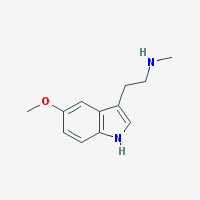Difference between revisions of "5-MeO-NMT"
(→Effects) |
(→Effects) |
||
| (2 intermediate revisions by one user not shown) | |||
| Line 9: | Line 9: | ||
== Effects == | == Effects == | ||
| − | + | 5-MeO-NMT is believed to produce few or no psychedelic effects, although very little data exists about its pharmacological properties or toxicity. | |
== Pharmacology, toxicity and general safety == | == Pharmacology, toxicity and general safety == | ||
Latest revision as of 18:15, 30 July 2021
Contents
- 1 Brief overview - What is 5-MeO-NMT?
- 2 Chemical and physical properties
- 3 Effects
- 4 Pharmacology, toxicity and general safety
- 5 Plants containing 5-MeO-NMT
- 6 Extraction teks
- 7 Dosages and consumption methods
- 8 History of usage
- 9 Analysis of 5-MeO-NMT
- 10 Scientific publications
- 11 Other links of interest
Brief overview - What is 5-MeO-NMT?
5-MeO-NMT is an alkaloid of unknown psychoactivity
Chemical and physical properties
Effects
5-MeO-NMT is believed to produce few or no psychedelic effects, although very little data exists about its pharmacological properties or toxicity.
Pharmacology, toxicity and general safety
Unknown activity (Shulgin & Shulgin 1997)
Animal studies mentioned in Ghosal l972a strongly suggest hallucinogenic activity but animal models cannot always be generalized (ref Trout's Notes)
Pharmacological studies: Robert G. Taborsky, William M. McIsaac 1963 suggests short acting, having "a moderately disruptive effect on conditioned behavior." ref [1]
Marczynski 1959 & 1960 ref Trout's Notes, Taborsky & Mcisaac 1964 ref Trout's Notes
Metabolism: Taborsky & Mcisaac 1964 ref Trout's notes
Plants containing 5-MeO-NMT
Anadenanthera colubrina var cebil (0.1% of bark as oxalate) (Iacobucci & Rúveda 1964), Anadenanthera peregrina (0.015% in bark) (Schultes et al. 1977). Arundo donax, Desmodium gyrans, Phalaris arundinacea (Boseb &Majaka 1977), Phalaris aquatica, Phalaris tuberosa, Virola theiodora.
